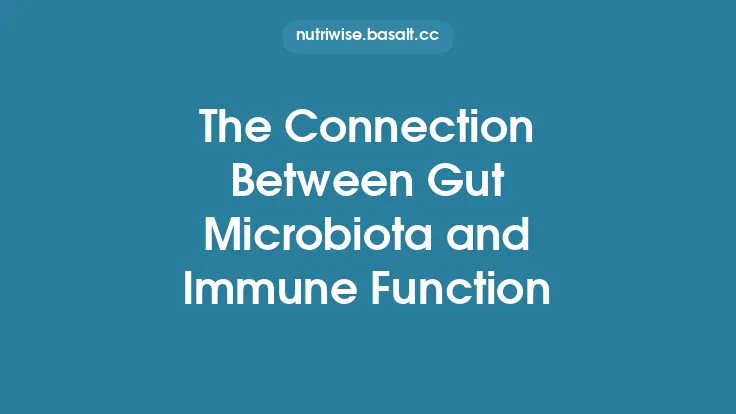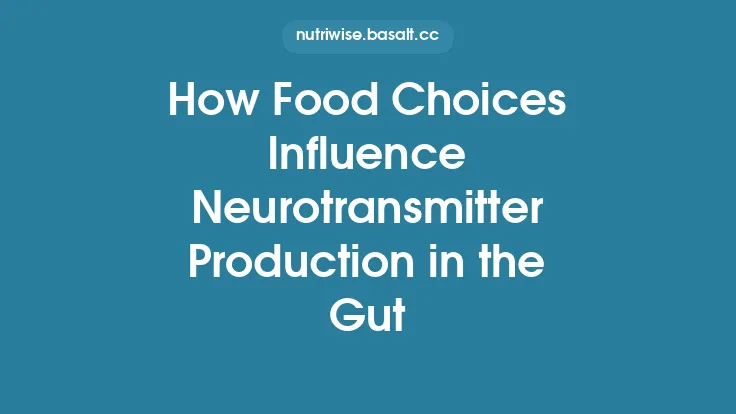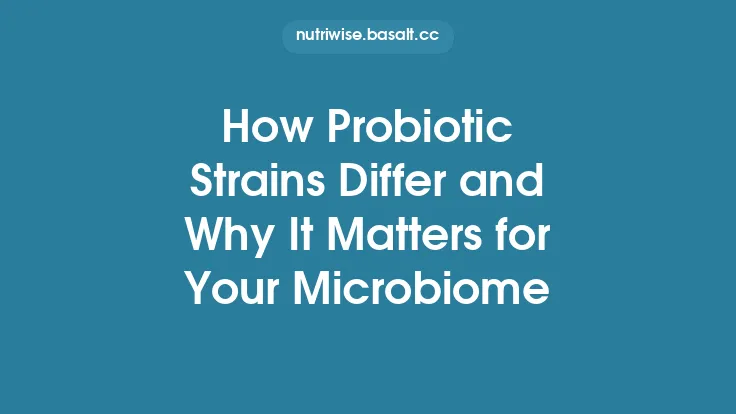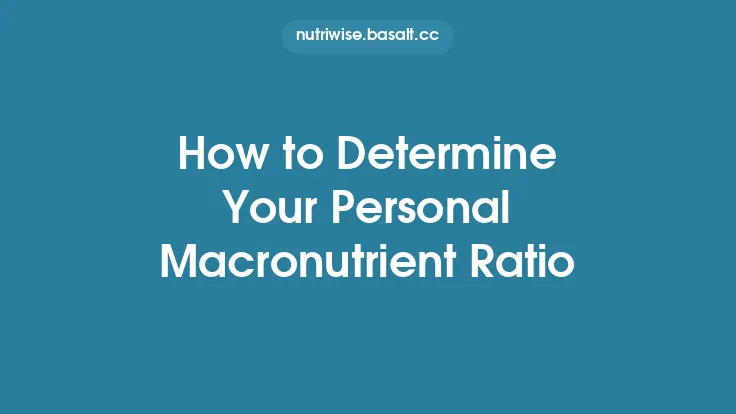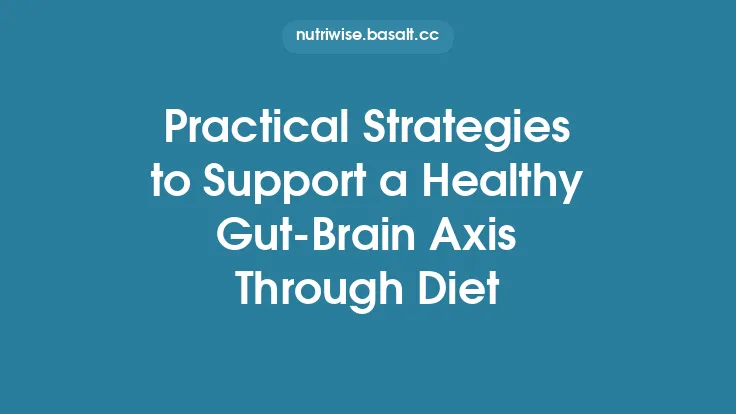The relationship between what we eat and the composition of the gut microbiota is a dynamic, bidirectional dialogue that unfolds throughout the gastrointestinal tract. While the gut microbiome is shaped by a multitude of factors—including genetics, environment, medication use, and early‑life exposures—diet stands out as the most potent and readily modifiable driver of microbial community structure. By providing substrates, altering physicochemical conditions, and influencing host secretions, dietary components can promote the growth of specific bacterial taxa, suppress others, and modulate the functional output of the entire ecosystem. Understanding these mechanisms is essential for interpreting research findings, designing nutritional interventions, and appreciating the broader implications of diet‑microbiota interactions for human physiology.
Macronutrient Composition and Microbial Communities
Macronutrients—carbohydrates, proteins, and fats—serve as the primary energy sources for both the host and its resident microbes. Their relative abundance in the diet exerts distinct selective pressures on microbial populations:
- Carbohydrates: Complex polysaccharides that escape digestion in the upper gastrointestinal tract become the main fuel for saccharolytic bacteria in the colon. High‑carbohydrate, low‑fat diets tend to enrich *Bacteroidetes and certain Firmicutes (e.g., Ruminococcaceae) that possess extensive carbohydrate‑active enzyme (CAZyme) repertoires. Conversely, diets low in fermentable carbohydrates reduce the substrate pool for these taxa, often leading to a relative increase in mucin‑degrading species such as Akkermansia muciniphila*.
- Proteins: Dietary protein that reaches the colon is metabolized by proteolytic bacteria, producing a suite of metabolites including branched‑chain fatty acids, ammonia, phenols, and indoles. High‑protein, low‑carbohydrate diets (e.g., certain ketogenic regimens) have been associated with an expansion of *Bacteroides spp. and Clostridium* clusters that specialize in amino acid fermentation, while simultaneously diminishing saccharolytic populations.
- Fats: Dietary lipids influence the gut microbiota both directly, by providing fatty acids that some bacteria can utilize, and indirectly, through the secretion of bile acids. High‑fat diets increase the concentration of primary bile acids in the intestine, which can be transformed by bile‑salt‑hydrolyzing bacteria (e.g., *Bacteroides and Clostridium* spp.) into secondary bile acids. These secondary bile acids possess antimicrobial properties that selectively inhibit certain Gram‑positive taxa, thereby reshaping community composition.
The balance among these macronutrients determines the relative availability of fermentable substrates versus nitrogenous and lipidic compounds, steering the microbiota toward either saccharolytic or proteolytic metabolic pathways.
Dietary Fiber: Types, Fermentation, and Microbial Responses
Fiber is a heterogeneous group of non‑digestible carbohydrates that includes soluble, insoluble, fermentable, and partially fermentable fractions. Its impact on the gut microbiota is mediated through several key dimensions:
- Molecular Structure: Linear versus branched polysaccharides, degree of polymerization, and the presence of side chains dictate which bacterial CAZymes can cleave the fiber. For instance, β‑glucans (found in oats and barley) are preferentially degraded by *Bifidobacterium and Lactobacillus species possessing β‑glucanases, whereas arabinoxylans (abundant in wheat) are targeted by Prevotella* spp. equipped with arabinoxylanases.
- Solubility and Viscosity: Soluble fibers such as pectins and inulin form viscous gels that slow transit time, providing a prolonged fermentation window for colonic microbes. This environment favors slow‑growing, butyrate‑producing bacteria like *Faecalibacterium prausnitzii and Roseburia* spp.
- Fermentation Kinetics: Rapidly fermentable fibers (e.g., fructooligosaccharides) are consumed in the proximal colon, leading to early production of acetate and lactate, while slowly fermentable fibers (e.g., resistant starch type 3) reach the distal colon, supporting butyrate synthesis in the region where it is most needed for epithelial health.
- Cross‑Feeding Networks: Primary degraders break down complex fibers into oligosaccharides and monosaccharides, which are then utilized by secondary fermenters. This syntrophic interaction expands the functional capacity of the microbiota and stabilizes community structure.
Collectively, the diversity of fiber types in the diet creates a mosaic of ecological niches, fostering a rich and resilient microbial ecosystem.
Dietary Fat and Bile Acids: Shaping Bacterial Populations
Beyond serving as an energy source, dietary fat modulates the gut microbiota through bile acid metabolism:
- Primary Bile Acid Secretion: High‑fat meals stimulate hepatic synthesis and gallbladder release of cholic and chenodeoxycholic acids. These amphipathic molecules possess detergent properties that can disrupt bacterial membranes, exerting selective pressure against bile‑sensitive taxa.
- Microbial Deconjugation and Transformation: Certain gut bacteria express bile salt hydrolases (BSH) that deconjugate primary bile acids, reducing their toxicity. Subsequent 7α‑dehydroxylation by *Clostridium* clusters converts them into secondary bile acids (e.g., deoxycholic acid, lithocholic acid). These secondary bile acids have distinct antimicrobial spectra, often suppressing Firmicutes while allowing Bacteroidetes to flourish.
- Signaling Effects: Secondary bile acids act as ligands for host receptors (FXR, TGR5) that influence intestinal motility, mucus secretion, and immune signaling. These host responses, in turn, alter the luminal environment, creating feedback loops that further shape microbial composition.
Thus, dietary fat exerts both direct antimicrobial effects via bile acids and indirect ecological influences through host‑mediated pathways.
Protein Sources and Their Metabolic Footprint
The origin of dietary protein—animal versus plant—introduces qualitative differences in amino acid composition, associated micronutrients, and accompanying non‑protein constituents:
- Animal Proteins: Rich in sulfur‑containing amino acids (cysteine, methionine) and heme iron, animal proteins promote the growth of proteolytic bacteria capable of producing hydrogen sulfide (H₂S) and other sulfur metabolites. Species such as *Bilophila wadsworthia* thrive under these conditions, and their expansion has been linked to pro‑inflammatory states in animal models.
- Plant Proteins: Typically accompanied by fiber, polyphenols, and anti‑nutritional factors (e.g., phytic acid), plant proteins are less likely to reach the colon in an intact form. The co‑presence of fermentable carbohydrates mitigates proteolysis by providing alternative energy sources, thereby favoring saccharolytic over proteolytic pathways.
- Processing Effects: Cooking methods (e.g., grilling, frying) generate advanced glycation end products (AGEs) and heterocyclic amines, which can be metabolized by specific bacterial enzymes, influencing community composition and metabolic output.
The net effect of protein intake on the gut microbiota is therefore contingent upon both the source and the matrix in which the protein is delivered.
Polyphenols and Other Phytochemicals as Microbial Modulators
Polyphenolic compounds—flavonoids, phenolic acids, lignans, and stilbenes—are abundant in fruits, vegetables, tea, coffee, and cocoa. Although poorly absorbed in the small intestine, they undergo extensive microbial transformation:
- Deglycosylation and Ring‑Fission: Gut bacteria possessing β‑glucosidases and tannase enzymes cleave sugar moieties and open aromatic rings, generating smaller phenolic metabolites (e.g., phenylpropionic acids) that can be absorbed systemically.
- Selective Antimicrobial Activity: Certain polyphenols exhibit bacteriostatic effects against Gram‑positive pathogens while sparing beneficial anaerobes, thereby subtly reshaping community composition.
- Prebiotic‑Like Effects: By providing a niche for bacteria capable of polyphenol metabolism (e.g., *Eubacterium ramulus, Eggerthella lenta*), these compounds promote the persistence of functional guilds that contribute to host antioxidant capacity and immune modulation.
The interplay between dietary polyphenols and the gut microbiota exemplifies a co‑evolutionary relationship where microbial metabolism unlocks the bioactivity of plant secondary metabolites.
Dietary Patterns and Their Signature Microbiota
Large‑scale cohort studies have identified characteristic microbial signatures associated with distinct dietary patterns:
- Western Diet: High in refined sugars, saturated fats, and animal protein, this pattern is linked to reduced microbial diversity, enrichment of *Bacteroides and Alistipes, and a relative depletion of fiber‑degrading Prevotella and Ruminococcaceae*.
- Mediterranean Diet: Emphasizing fruits, vegetables, legumes, whole grains, nuts, and olive oil, this diet correlates with increased abundance of *Faecalibacterium, Roseburia, and Akkermansia*, alongside higher production of short‑chain fatty acids (SCFAs).
- Plant‑Based/Vegan Diets: Predominantly carbohydrate‑rich and low in animal fat, these diets foster a *Prevotella*-dominant enterotype, reflecting the high intake of complex polysaccharides.
- Ketogenic/Low‑Carbohydrate Diets: Marked by elevated fat and protein intake with minimal fermentable carbohydrates, these regimens often lead to a rise in *Bacteroides and Clostridium* clusters, accompanied by reduced SCFA concentrations.
These pattern‑level observations underscore the cumulative effect of multiple dietary components acting in concert to sculpt the gut microbial landscape.
Temporal Dynamics: Acute vs. Chronic Dietary Changes
The gut microbiota responds to dietary perturbations on both short‑term (hours to days) and long‑term (weeks to months) timescales:
- Acute Shifts: Within 24–48 hours of a dietary switch, relative abundances of fast‑growing taxa can fluctuate dramatically. For example, a sudden increase in simple sugars can cause a bloom of *Enterobacteriaceae, while a rapid rise in fiber intake may boost Bifidobacterium* populations.
- Stabilization Phase: Over weeks, the community reaches a new equilibrium that reflects the sustained nutrient milieu. Persistent dietary habits lead to stable alterations in functional gene repertoires, such as increased CAZyme diversity in high‑fiber diets.
- Resilience and Hysteresis: Some microbial configurations exhibit hysteresis, where returning to a previous diet does not fully restore the original community composition, indicating that certain dietary exposures can have lasting imprinting effects.
Understanding these temporal patterns is crucial for interpreting intervention studies and for predicting the durability of diet‑induced microbiome changes.
Mechanistic Pathways: Metabolite‑Mediated Crosstalk
Diet‑driven microbial metabolism generates a spectrum of metabolites that act as signaling molecules for both the host and the microbial community:
- Short‑Chain Fatty Acids (SCFAs): Acetate, propionate, and butyrate arise from carbohydrate fermentation. SCFAs serve as energy substrates for colonocytes, modulate gut barrier integrity, and influence host gene expression via histone deacetylase inhibition.
- Branched‑Chain Fatty Acids (BCFAs): Produced from protein fermentation, BCFAs (isobutyrate, isovalerate) can affect mucosal immunity and have been linked to altered lipid metabolism.
- Secondary Bile Acids: As discussed, these metabolites exert antimicrobial effects and act as ligands for host nuclear receptors, influencing metabolic and inflammatory pathways.
- Indoles and Phenols: Derived from tryptophan and tyrosine catabolism, these compounds can modulate intestinal permeability and interact with the aryl hydrocarbon receptor (AhR), affecting mucosal immunity.
The net physiological impact of a diet is therefore mediated not only by the composition of the microbiota but also by the functional output of microbial metabolism.
Methodological Approaches to Study Diet‑Microbiota Interactions
Robust investigation of how diet shapes the gut microbiota relies on a combination of experimental and analytical techniques:
- Metagenomic Sequencing: Shotgun sequencing provides taxonomic resolution to the species level and enables functional profiling of microbial gene families (e.g., CAZymes, BSH genes).
- Metatranscriptomics and Metaproteomics: These approaches capture active gene expression and protein production, revealing real‑time metabolic responses to dietary inputs.
- Metabolomics: Targeted and untargeted mass spectrometry analyses quantify microbial metabolites (SCFAs, bile acids, polyphenol derivatives) in fecal, plasma, or urine samples, linking microbial activity to host physiology.
- Controlled Feeding Trials: Iso‑caloric, crossover designs with tightly regulated diets allow attribution of microbial changes to specific nutrients while minimizing confounding variables.
- In Vitro Fermentation Models: Batch cultures, continuous‑flow systems (e.g., SHIME), and colon‑on‑a‑chip platforms simulate the colonic environment, enabling mechanistic dissection of substrate‑microbe interactions.
- Computational Modeling: Genome‑scale metabolic models and machine‑learning frameworks predict community responses to dietary perturbations and identify keystone taxa.
Integrating these methodologies yields a multidimensional view of diet‑microbiota dynamics, facilitating the translation of observational findings into mechanistic insight.
Implications for Health and Disease
While the present article refrains from prescribing specific interventions, it is worth noting that diet‑induced microbial alterations have been implicated in a spectrum of health outcomes:
- Metabolic Regulation: Shifts toward SCFA‑producing communities are associated with improved insulin sensitivity and lipid homeostasis, whereas proteolytic, bile‑acid‑rich profiles have been linked to dyslipidemia and hepatic steatosis.
- Neuro‑Gut Axis: Microbial metabolites such as tryptophan‑derived indoles can cross the blood‑brain barrier and influence neurotransmitter pathways, suggesting a dietary route to modulating mood and cognition.
- Oncogenesis: Certain secondary bile acids and microbial metabolites derived from red meat protein have been associated with increased colorectal cancer risk, whereas fiber‑driven butyrate production exerts protective effects on colonic epithelium.
- Cardiovascular Health: Diet‑driven changes in microbial trimethylamine (TMA) production, a precursor to the pro‑atherogenic metabolite TMAO, illustrate how nutrient‑microbe interactions can impact vascular disease risk.
These associations underscore the centrality of diet as a lever for modulating microbial functions that intersect with systemic physiology.
Future Directions and Emerging Technologies
The field is rapidly evolving, with several promising avenues poised to deepen our understanding of diet‑microbiota interplay:
- Personalized Nutrition Platforms: Integration of individual genomic, metabolomic, and microbiome data into predictive algorithms aims to tailor dietary recommendations that optimize microbial function for each person.
- Synthetic Microbial Consortia: Engineered communities with defined metabolic capabilities could be administered alongside specific diets to achieve targeted metabolite production.
- Real‑Time Monitoring: Wearable sensors coupled with non‑invasive fecal sampling technologies may enable continuous tracking of microbial metabolites, providing feedback loops for dietary adjustments.
- CRISPR‑Based Functional Screens: Genome editing in gut isolates allows systematic interrogation of gene‑diet interactions, revealing causal links between microbial pathways and host outcomes.
- Longitudinal Cohort Studies with Multi‑Omics: Large, diverse populations followed over years, with repeated dietary assessments and deep microbiome profiling, will clarify the temporal stability of diet‑induced microbial changes and their long‑term health implications.
Advancements in these areas will transform descriptive observations into actionable knowledge, paving the way for evidence‑based strategies that harness diet to shape the gut microbiota in beneficial ways.
In sum, diet exerts a profound and multifaceted influence on the gut microbiota through substrate provision, physicochemical modulation, and host‑mediated signaling. By dissecting the specific effects of macronutrients, fiber types, fats, proteins, and phytochemicals, and by employing sophisticated methodological tools, researchers are unraveling the complex ecological networks that underlie diet‑microbe interactions. This foundational understanding is essential for interpreting the broader health consequences of dietary patterns and for guiding future innovations in nutrition science.
